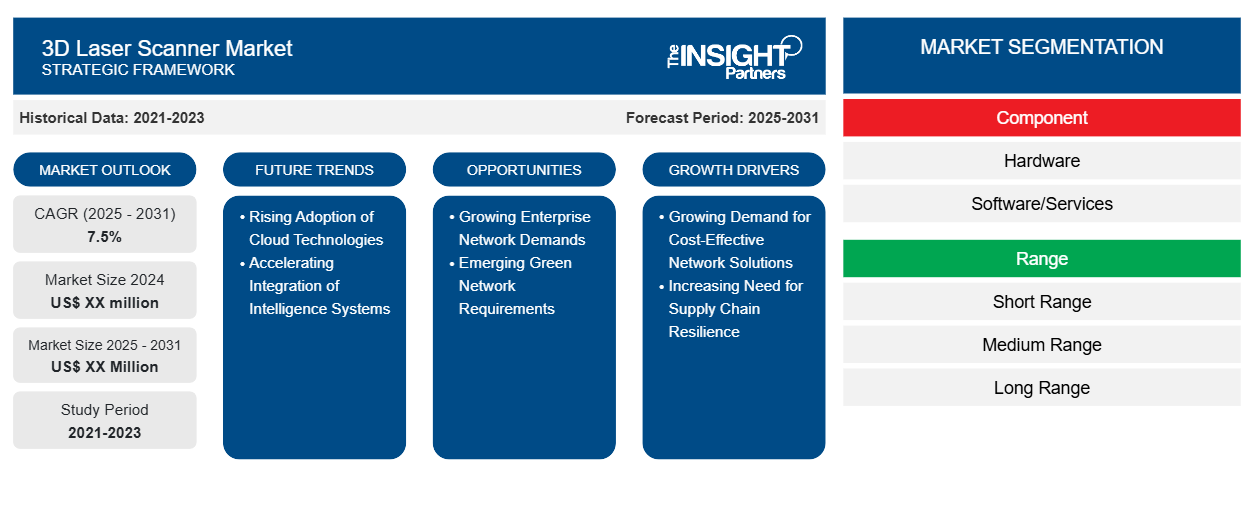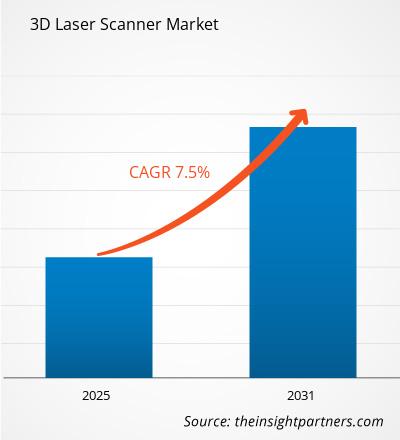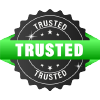The 3D Laser Scanner Market is expected to register a CAGR of 7.5% from 2025 to 2031, with a market size expanding from US$ XX million in 2024 to US$ XX Million by 2031.
The report is segmented by Component (Hardware, Software/Services), Range (Short Range, Medium Range, Long Range), Technology (Laser Triangulation, Structured Light Technology, Pattern Fringe Triangulation, Pulse Based, Phase Shift, Others), Industry Verrtical (Aerospace and Defense, Automotive, Construction and Infrastructure, Electronics and Semiconductors, Artifact and Heritage Preservation, Others). The global analysis is further broken-down at regional level and major countries. The Report Offers the Value in USD for the above analysis and segments.
Purpose of the Report
The report 3D Laser Scanner Market by The Insight Partners aims to describe the present landscape and future growth, top driving factors, challenges, and opportunities. This will provide insights to various business stakeholders, such as:
- Technology Providers/Manufacturers: To understand the evolving market dynamics and know the potential growth opportunities, enabling them to make informed strategic decisions.
- Investors: To conduct a comprehensive trend analysis regarding the market growth rate, market financial projections, and opportunities that exist across the value chain.
- Regulatory bodies: To regulate policies and police activities in the market with the aim of minimizing abuse, preserving investor trust and confidence, and upholding the integrity and stability of the market.
3D Laser Scanner Market Segmentation
Component
- Hardware
- Software/Services
Range
- Short Range
- Medium Range
- Long Range
Technology
- Laser Triangulation
- Structured Light Technology
- Pattern Fringe Triangulation
- Pulse Based
- Phase Shift
Industry Verrtical
- Aerospace and Defense
- Automotive
- Construction and Infrastructure
- Electronics and Semiconductors
- Artifact and Heritage Preservation
You will get customization on any report - free of charge - including parts of this report, or country-level analysis, Excel Data pack, as well as avail great offers and discounts for start-ups & universities
3D Laser Scanner Market: Strategic Insights

-
Get Top Key Market Trends of this report.This FREE sample will include data analysis, ranging from market trends to estimates and forecasts.
3D Laser Scanner Market Growth Drivers
- Growing Demand for Cost-Effective Network Solutions: The pressing need for mobile operators to reduce both CAPEX and OPEX is driving Open RAN adoption. Traditional RAN architectures lock operators into proprietary, single-vendor solutions with high costs. Open RAN's disaggregated approach enables operators to mix and match components from different vendors, fostering competition and reducing costs by up to 30%. The standardized interfaces also simplify network maintenance and upgrades, while the software-defined nature allows for more efficient resource utilization and automation, further reducing operational expenses. This cost advantage is particularly compelling for operators planning 5G network deployments or looking to modernize existing infrastructure.
- Increasing Need for Supply Chain Resilience: The growing desire to reduce dependency on traditional telecom equipment vendors, particularly in light of geopolitical concerns and supply chain vulnerabilities, is propelling Open RAN forward. Operators seek to avoid vendor lock-in and create more resilient supply chains by having multiple supplier options. This diversification also stimulates innovation as smaller vendors and startups can enter the market with specialized solutions. The ability to integrate best-of-breed components from various vendors gives operators more control over their network architecture and enables them to optimize performance based on specific requirements and local conditions.
3D Laser Scanner Market Future Trends
- Rising Adoption of Cloud Technologies: Open RAN is increasingly embracing cloud-native principles and containerization, marking a significant shift from traditional telecom infrastructure. This trend enables greater flexibility, scalability, and automation in network deployment and management. Operators are leveraging containerized network functions and microservices architecture to achieve better resource utilization and faster service deployment. The cloud-native approach also facilitates edge computing integration, enabling operators to dynamically allocate network resources and optimize performance based on real-time demands. This evolution is attracting cloud providers and software companies to the telecom space, fostering innovation and new partnership models.
- Accelerating Integration of Intelligence Systems: The integration of artificial intelligence and machine learning capabilities into Open RAN architectures is emerging as a key trend. These technologies enable intelligent network optimization, predictive maintenance, and automated operation of radio access networks. AI/ML algorithms can analyze vast amounts of network data to optimize radio resource management, improve energy efficiency, and enhance user experience. The standardized interfaces in Open RAN make it easier to implement AI-powered solutions across different vendor components. This trend is driving collaboration between traditional telecom players and AI technology providers, creating new opportunities for network innovation.
3D Laser Scanner Market Opportunities
- Growing Enterprise Network Demands: The enterprise private network market offers a substantial opportunity for Open RAN adoption. Industries such as manufacturing, mining, ports, and healthcare increasingly demand dedicated wireless networks with specific performance characteristics. Open RAN's flexibility and customization capabilities make it well-suited for these specialized deployments. The ability to integrate with existing IT systems and maintain control over network data is particularly attractive to enterprises. This market segment also provides opportunities for system integrators and specialized solution providers to create industry-specific Open RAN offerings.
- Emerging Green Network Requirements: The growing focus on environmental sustainability creates an opportunity for Open RAN to deliver energy-efficient network solutions. The software-defined nature of Open RAN enables intelligent power management and optimization of network resources based on actual usage patterns. Advanced sleep modes and dynamic capacity allocation can significantly reduce energy consumption compared to traditional RAN deployments. This opportunity aligns with operators' sustainability goals and regulatory requirements for reducing carbon emissions. The potential for energy cost savings also strengthens the overall business case for Open RAN adoption, particularly in regions with high energy costs.
3D Laser Scanner Market Regional Insights
The regional trends and factors influencing the 3D Laser Scanner Market throughout the forecast period have been thoroughly explained by the analysts at The Insight Partners. This section also discusses 3D Laser Scanner Market segments and geography across North America, Europe, Asia Pacific, Middle East and Africa, and South and Central America.
3D Laser Scanner Market Report Scope
| Report Attribute | Details |
|---|---|
| Market size in 2024 | US$ XX million |
| Market Size by 2031 | US$ XX Million |
| Global CAGR (2025 - 2031) | 7.5% |
| Historical Data | 2021-2023 |
| Forecast period | 2025-2031 |
| Segments Covered |
By Component
|
| Regions and Countries Covered |
North America
|
| Market leaders and key company profiles |
|
3D Laser Scanner Market Players Density: Understanding Its Impact on Business Dynamics
The 3D Laser Scanner Market is growing rapidly, driven by increasing end-user demand due to factors such as evolving consumer preferences, technological advancements, and greater awareness of the product's benefits. As demand rises, businesses are expanding their offerings, innovating to meet consumer needs, and capitalizing on emerging trends, which further fuels market growth.

- Get the 3D Laser Scanner Market top key players overview
Key Selling Points
- Comprehensive Coverage: The report comprehensively covers the analysis of products, services, types, and end users of the 3D Laser Scanner Market, providing a holistic landscape.
- Expert Analysis: The report is compiled based on the in-depth understanding of industry experts and analysts.
- Up-to-date Information: The report assures business relevance due to its coverage of recent information and data trends.
- Customization Options: This report can be customized to cater to specific client requirements and suit the business strategies aptly.
The research report on the 3D Laser Scanner Market can, therefore, help spearhead the trail of decoding and understanding the industry scenario and growth prospects. Although there can be a few valid concerns, the overall benefits of this report tend to outweigh the disadvantages.
Frequently Asked Questions
What are the deliverable formats of the 3D laser scanner market report?
What are the options available for the customization of this report?
What are the future trends of the 3D laser scanner market?
1. Integration with BIM (Building Information Modeling)
2. Miniaturization and Portability
3. Real-Time Data Processing and Cloud Integration
What are the driving factors impacting the 3D laser scanner market?
1. Growing Demand for Digital Twin Technology
2. Increased Adoption in the Automotive and Aerospace Industries
3. Cost-Effectiveness in Surveying and Mapping
What is the expected CAGR of the 3D Laser Scanner Market Size and Forecasts (2021 - 2031), Global and Regional Share, Trends, and Growth Opportunity Analysis Report Coverage: By Component (Hardware, Software/Services), Range (Short Range, Medium Range, Long Range), Technology (Laser Triangulation, Structured Light Technology, Pattern Fringe Triangulation, Pulse Based, Phase Shift, Others), Industry Verrtical (Aerospace and Defense, Automotive, Constriction and Infrastructure, Electronics and Semiconductors, Artifact and Heritage Preservation, Others), and Geography (North America, Europe, Asia Pacific, Middle East & Africa, South & Central America)?
- Historical Analysis (2 Years), Base Year, Forecast (7 Years) with CAGR
- PEST and SWOT Analysis
- Market Size Value / Volume - Global, Regional, Country
- Industry and Competitive Landscape
- Excel Dataset
Recent Reports
Related Reports
Testimonials
Reason to Buy
- Informed Decision-Making
- Understanding Market Dynamics
- Competitive Analysis
- Identifying Emerging Markets
- Customer Insights
- Market Forecasts
- Risk Mitigation
- Boosting Operational Efficiency
- Strategic Planning
- Investment Justification
- Tracking Industry Innovations
- Aligning with Regulatory Trends





















 Get Free Sample For
Get Free Sample For